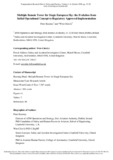JavaScript is disabled for your browser. Some features of this site may not work without it.
| dc.contributor.author | Kearney, Peter | |
| dc.contributor.author | Li, Wen-Chin | |
| dc.date.accessioned | 2018-07-27T10:38:38Z | |
| dc.date.available | 2018-07-27T10:38:38Z | |
| dc.date.issued | 2018-06-18 | |
| dc.identifier.citation | Kearney P, Li W-C, Multiple remote tower for Single European Sky: the evolution from initial operational concept to regulatory approved implementation, Transportation Research Part A: Policy and Practice, Volume 116, Issue October, 2018, pp. 15-30 | en_UK |
| dc.identifier.issn | 0965-8564 | |
| dc.identifier.uri | http://dx.doi.org/10.1016/j.tra.2018.06.005 | |
| dc.identifier.uri | https://dspace.lib.cranfield.ac.uk/handle/1826/13362 | |
| dc.description.abstract | The European Union project of Single European Sky initiated a reorganization of European airspace and proposed additional measures for air traffic management to achieve the key objectives of improving efficiency and capacity while at the same time enhancing safety. The concept of multiple remote tower operation is that air traffic controllers (ATCOs) can control several airfields from a distant virtual control centre. The control of multiple airfields can be centralised to a virtual centre permitting the more efficient use of ATCO resources. This research was sponsored by the Single European Sky ATM Research Program and the ATM Operations Division of the Irish Aviation Authority. A safety case was developed for migration of multiple remote tower services to live operations. This research conducted 50 large scale demonstration trials of remote tower operations from single tower operations to multiple tower operations for safety assessment by air navigation safety regulators in 2016. A dedicated team of air traffic controllers and technology experts successfully completed the safety assessment of multiple remote tower operations in real time. The implementation of this innovative technology requires a careful balance between cost-efficiency and the safety of the air traffic control in terms of capacity and human performance. The live trial exercises demonstrated that the air traffic services provided by the remote tower for a single airport and two medium airports by a single ATCO with ‘in sequence’ and ‘simultaneous’ aircraft operation was at least as safe as provided by the local towers at Cork and Shannon aerodromes. No safety occurrence was reported nor did any operational safety issue arise during the conduct of the fifty live trial exercises. | en_UK |
| dc.language.iso | en | en_UK |
| dc.publisher | Elsevier | en_UK |
| dc.rights | Attribution-NonCommercial-NoDerivatives 4.0 International | * |
| dc.rights.uri | http://creativecommons.org/licenses/by-nc-nd/4.0/ | * |
| dc.subject | Air traffic control | en_UK |
| dc.subject | Cost efficiency | en_UK |
| dc.subject | Human performance | en_UK |
| dc.subject | Multiple remote tower operations | en_UK |
| dc.subject | Safety assessment | en_UK |
| dc.subject | Single European Sky | en_UK |
| dc.title | Multiple remote tower for Single European Sky: The evolution from initial operational concept to regulatory approved implementation | en_UK |
| dc.type | Article | en_UK |
| dc.identifier.cris | 20831749 |
Files in this item
The following license files are associated with this item:
This item appears in the following Collection(s)
-
Staff publications (SATM) [4364]

